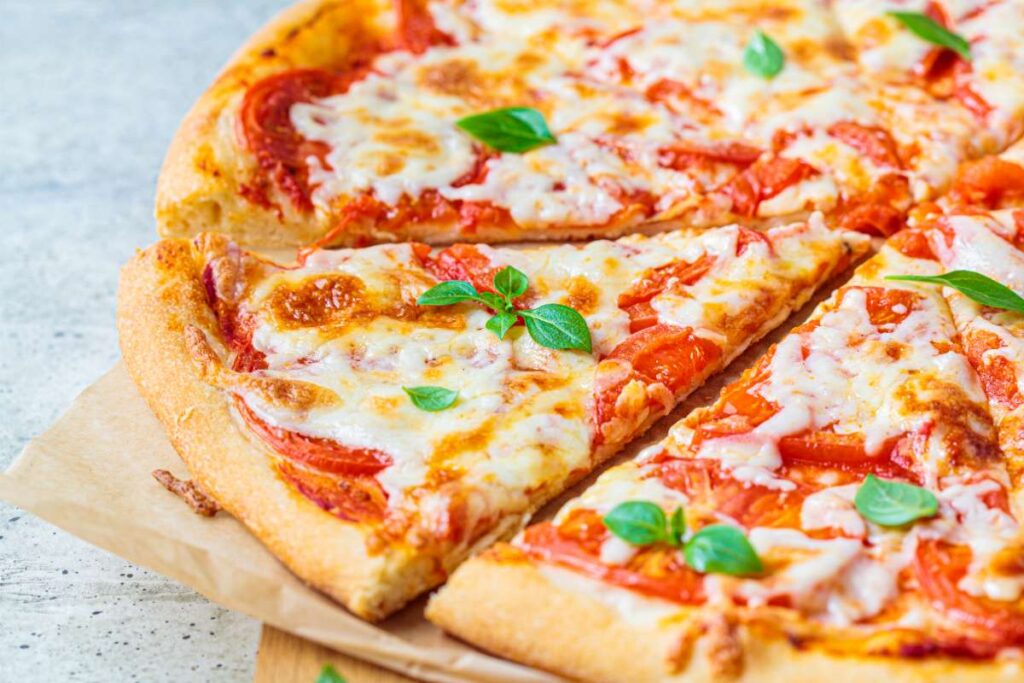Introduction
Classic Pizza: A Timeless Delight
Ah, classic pizza – a phrase that instantly conjures images of gooey cheese, tangy tomato sauce, and a crust that strikes the perfect balance between crispy and chewy. It’s not just a dish; it’s a worldwide love affair. This affair reminds us of home, no matter where we’re from. But what exactly makes a pizza “classic”? Is it the age-old traditions passed down through generations? Is it the simplicity of its ingredients, or the way it brings people together? Indeed, it’s all of the above and so much more.
Diving into the essence of classic pizza is like opening a treasure chest of culinary history. From the bustling streets of Naples to the busy avenues of New York, each slice tells a story. It’s a story of migration, innovation, and the universal language of taste. This journey isn’t just about learning how to layer the perfect toppings. Nor is it solely about achieving that airy crust. Rather, it’s about celebrating a dish that has become a staple in our collective gastronomic memory.
In the chapters that follow, we’ll unwrap the layers of classic pizza. We start from its roots in Italian cuisine to its status as a global icon. We’ll explore the alchemy of dough, sauce, and toppings that has been perfected over centuries. Additionally, we’ll share secrets to recreating this magic in your own kitchen. Whether you’re a seasoned pizzaiolo or a curious home cook, prepare to be whisked away. You’re on a deliciously historical adventure that pays homage to pizza’s rightful place at the table of culinary legends. Join us as we savor each bite of this timeless delight. It’s a testament to the simple, yet profound joy that good food can bring into our lives.
The History of Classic Pizza
The Origins of Pizza
Let’s take a moment to journey back in time. The story of pizza begins in Italy. Yet, the exact birthplace of this culinary marvel remains a topic of spirited debate. Nevertheless, one thing is crystal clear: the concept of bread with toppings has a long and rich history. It predates the modern pizza we adore today. Ancient civilizations, including the Greeks and Egyptians, enjoyed similar dishes. They seasoned flatbreads with herbs and oil. Let’s journey back in time to Italy, where pizza found its soul in Naples during the 18th century, becoming a quick, affordable meal for the working class. This section could segue into discussing the variety of Italian dishes that share the same spirit of simplicity and tradition, such as the Chicken Tortellini Alfredo, showcasing the breadth of Italian cuisine.
Evolution into the Classic Pizza
As time marched on, so did the evolution of pizza. The introduction of tomatoes to Europe from the Americas was a game-changer. Initially, tomatoes were met with suspicion. Many believed them to be poisonous. However, once this myth was dispelled, tomatoes became a staple in Italian cooking. It wasn’t long before the vibrant, tangy sauce found its way onto pizza. This addition transformed the dish into something extraordinary. Mozzarella cheese, another key ingredient, then joined the ensemble. Together, these elements formed the holy trinity of pizza toppings: tomato, mozzarella, and basil. These ingredients represent the colors of the Italian flag. They are also the hallmark of the iconic Pizza Margherita. Named in honor of Queen Margherita of Savoy, this version epitomizes the essence of classic pizza. It’s a testament to simplicity and flavor that continues to captivate pizza lovers worldwide.
As classic pizza began to weave its way into the fabric of Italian culture, it also started its global journey. Italian immigrants carried their cherished recipes across oceans. They introduced this beloved dish to new lands. In cities like New York and Chicago, pizza underwent further transformation. It adapted to local tastes and ingredients. Yet, it always maintained its soulful connection to its Neapolitan roots. Today, classic pizza stands as a global phenomenon. It’s a dish that transcends cultural and geographical boundaries. Its story is a mosaic of innovation, tradition, and the universal pursuit of deliciousness.
Essential Ingredients of Classic Pizza

The Dough – The Foundation
At the heart of every classic pizza lies the dough, the canvas upon which all other ingredients proudly sit. Achieving the perfect dough is both an art and a science; it requires precision, patience, and a touch of intuition. The essential components—flour, water, yeast, and salt—combine in a symphony of simplicity. Yet, the variations in preparation and proofing can result in a myriad of textures and flavors. For the authentic classic pizza, the dough should be soft and pliable, allowing it to stretch thinly without tearing, yet sturdy enough to hold the toppings. This delicate balance creates a crust that’s crispy on the outside, yet chewy and airy on the inside—a true hallmark of perfection.
The Sauce – A Flavorful Canvas
The sauce acts as the flavorful canvas for classic pizza. It bridges the dough and toppings with its rich, tangy essence. Traditionally, makers craft the sauce from ripe tomatoes. These tomatoes are handpicked for their vibrant flavor. They’re then blended with a selection of herbs and garlic. This mixture is simmered to perfection. It becomes thick enough to spread evenly across the dough. Yet, it remains fluid enough to imbue every bite with its robust character. The simplicity of the sauce is its strength. It provides a foundation. This foundation enhances the flavors of the toppings, rather than overwhelming them.
The Toppings – Simplicity Meets Flavor
When it comes to toppings, classic pizza embodies the principle that less is more. A few high-quality ingredients are chosen for their complementary flavors and textures, creating a harmonious blend that sings with every bite. Mozzarella cheese, with its creamy texture and delicate taste, is a staple. It’s often joined by a sprinkling of fresh basil leaves, adding a fragrant, herby note that lifts the dish. For those who favor a bit more complexity, ingredients like anchovies, olives, or a drizzle of extra virgin olive oil can add depth and richness. The key is balance; each topping should shine without overshadowing its companions.
Making Classic Pizza at Home
Preparing the Perfect Dough
Embarking on the journey of making classic pizza at home starts with the dough. Begin by combining your flour, water, yeast, and salt in a mixing bowl, kneading until the mixture becomes a smooth, elastic ball. This process activates the gluten in the flour, giving the dough its stretchy texture. Allow the dough to rest and rise in a warm place; this proofing stage is crucial for developing flavor and texture. After the dough has doubled in size, punch it down gently and divide it into balls. Each ball will be the base for a single pizza, ready to be stretched and shaped to your liking.
Sauce and Toppings – Layering Flavors
With your dough prepared, it’s time to layer on the flavors. Spread a generous spoonful of your tomato sauce over the surface, leaving a small border around the edge. This border will puff up beautifully in the oven, creating the iconic pizza crust. Next, scatter slices of mozzarella cheese across the sauce, followed by any additional toppings you desire. Remember, the beauty of classic pizza lies in its simplicity; a few well-chosen toppings can elevate the dish to new heights.
Baking Techniques – Achieving the Perfect Crust
The final step in creating your classic pizza masterpiece is baking. A hot oven is essential for achieving that perfect crust; preheat yours to the highest setting, ideally between 475°F (245°C) and 500°F (260°C). If you have a pizza stone, place it in the oven during preheating; it will mimic the conditions of a traditional pizza oven, providing an even, intense heat that cooks the pizza from below. Slide your pizza onto the stone and bake until the crust is golden and the cheese is bubbling and slightly browned. This process usually takes about 10 to 15 minutes, depending on your oven.
Emerging hot from the oven, your classic pizza is a testament to the timeless appeal of simple, high-quality ingredients brought together with care and passion. Each slice is a bite of history, a blend of tradition and personal creativity that continues to make pizza one of the world’s favorite foods.
Classic Pizza Varieties
Neapolitan Pizza – The Original
Neapolitan pizza, sitting at the apex of pizza’s storied lineage, actively embodies the essence of Naples, Italy. Its characteristics include a thin, soft crust, vibrant tomato sauce, mozzarella di bufala, fresh basil, and a touch of extra virgin olive oil, perfecting simplicity. A blisteringly hot wood-fired oven bakes it, allowing it to emerge charred and bubbly, marking it as an authentic masterpiece. Neapolitan pizza transcends the simple definition of a dish; UNESCO recognizes it as a cultural treasure, testifying to the timeless art of pizza making.
New York-Style Pizza – The American Twist
Halfway across the world, New York-style pizza introduces a delightful twist on the classic. Its thin, crisp base, foldable in half, suits the bustling urban lifestyle perfectly. Generous toppings of tomato sauce and shredded mozzarella adorn it, often coming in wide slices ideal for on-the-go consumption. This version of classic pizza honors its Italian origins while celebrating New York City’s diverse culinary scene.
FAQs About Classic Pizza

Frequently Asked Questions
- What’s the secret to a perfect pizza crust? The key lies in the dough’s hydration, kneading, and proofing time. A well-hydrated dough, combined with adequate kneading and sufficient resting, results in a crust that’s crispy on the outside and chewy on the inside.
- Can you use store-bought sauce for your pizza? Although homemade sauce is preferred for its freshness and flavor, a high-quality store-bought sauce can certainly be a convenient alternative.
- How do I achieve a crispy crust in a home oven? Preheating your oven to its highest temperature and using a pizza stone or baking steel can mimic the conditions of a pizza oven, resulting in a crispier crust.
For more insights into the origins and evolution of pizza, explore the History of Pizza, which delves deeper into this culinary marvel’s journey from Naples to the rest of the world.
Conclusion
Celebrating the Timeless Classic
In our journey through the world of classic pizza, we’ve traversed its history, dissected its components, and even ventured into making it within our own kitchens. From the humble streets of Naples to the bustling avenues of New York, classic pizza has stood the test of time, evolving yet retaining its essence. This exploration isn’t just about ingredients or techniques; it’s a celebration of a dish that has become a global symbol of joy, unity, and the simple pleasures of eating well.
Whether it’s the traditional Neapolitan pizza, with its charred, bubbly crust and simple toppings, or the hearty, foldable New York-style slice, classic pizza continues to capture hearts and palates around the world. Each variety, each slice, tells a story. It’s a story of cultural exchange, culinary innovation, and the universal language of food.
As we conclude our savory expedition, let’s carry forward the spirit of classic pizza. Let’s gather, share, and savor the moments that bring us together, one delicious slice at a time. In doing so, we pay homage to the timeless delight that is classic pizza. It’s a dish that, in its simplicity, embodies the profound joy of cooking and eating.

